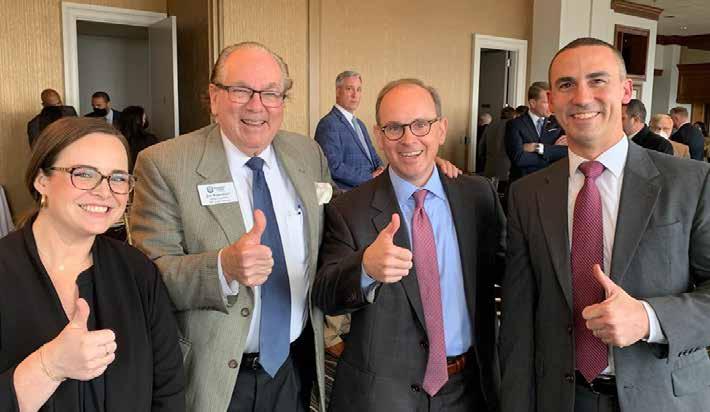
4 minute read
Free Justice: A History of the Public Defender in Twentieth-Century America
unfriendly feeling on his part may be safely set down as one element of his wonderful success in organizing the loyal American people for the tremendous conflict before them…. Had he put the abolition of slavery before the salvation of the Union, he would have inevitably driven from him a powerful class of the American people and rendered resistance to rebellion impossible.”
Douglass was a wise man.
Advertisement
Henry Cohen was a legislative attorney with the Congressional Research Service, Library of Congress, from 1975 to 2010, and was the book review editor of The Federal Lawyer from 1989 to 2017. Since 2021, he has been the copy editor of The Lincoln Forum Bulletin. © 2022 Henry Cohen. All rights reserved.
By Sara Mayeux
The University of North Carolina Press, 2020 296 pages; $32.95
Reviewed by Jon M. Sands
Public defenders are integral to the criminal justice system. They are extolled as heroic—a testament to American justice—and blamed as ineffective. They are viewed both as solitary paladins and as participants in a cruel system interested only in churning out cases. The idealistic vision is of a public defender doing everything possible in fighting for their indigent client and achieving justice. Too often, the reality is a public defender facing daunting odds, working in dismal conditions, in desperate financial straits, and with a crushing caseload. Their clients view them with suspicion, deride them as “public pretenders,” and view them as part of the very system aligned against the indigent. Between the idealistic vision and the grim reality, how exactly did the public defender become a legal stalwart, called to constitutional service by Gideon’s trumpet. This is the subject of Sara Mayeux’s revelatory study.
In Free Justice, Mayeux explains “how and why lawyers came to believe in the public defender as a quintessentially American institution, one that ideally should exist in communities all around the country.” Her history of the origin of the modern public defender system is at odds with the story the profession has told itself. The bar did not rally around “an apolitical, professional commitment to ‘due process’ or ‘rule of law.’ Rather, it is a story of contestation and uncertainty … over the proper relationship between lawyers, markets, and the modern state.” Mayeux follows how these competing narratives play out in case studies examining the establishment of institutional public defending. She contrasts Gideon’s triumphant and lofty promise that the Sixth Amendment ensures a right to counsel with the circumscribed reality of local public defense. Her important study of the institution’s history chronicles how we got where we are and ends by charting some paths forward.
Mayeux advances two explanations for the rise of public defenders. First, the legal profession saw the United States as a liberal democracy maintained by lawyers committed to the rule of law. This liberal ideology, under which lawyers serve individuals, contrasted with socialism and communism, under which lawyers serve the state. Second, support for public defenders was partial. Although funding counsel for the criminally accused was virtuous, representation was only for the criminally accused and came with a limited scope and inadequate funding. The legal profession and the government were ambivalent, providing just enough support to bolster the rule of law, but not enough to serve as a wedge to achieve further affirmative rights, such as equality, public assistance, and health care. The grudging support has frustrated the public defender system and resulted in continuing curtailment of its scope.
The ideal of the public defender arose at the turn of the century. Progressives advanced a vision of social reforms across all of society, and especially in urban communities. They would reform education, social welfare, health care, and law. Instead of private defenders, replete with corruption and unscrupulous practices, reformers envisioned public defenders as working not only for their clients but for the public at large. Adequately funded, they would hold themselves to a higher standard than the unscrupulous private bar. Public defenders, it was envisioned, would both represent the indigent and work with prosecutors to address a range of legal and social problems. Reformers, academics, and progressive lawyers circulated proposals. They found a willingness to experiment out West, especially in California (the first public defender organization was established in Los Angeles). The eastern established bar and other entrenched interests were unreceptive and derided the proposals as untenable, unworkable, and socialistic. Charitable pro bono legal aid was one thing; government funding was a threat to their livelihoods.
The rise of communism and fascism, the World War II, and the civil rights movement renewed interest in providing public defenders. The Cold War provided the final impetus: Funding public defenders was reimagined and recast as an American right. They became viewed not as a socialist endeavor but as an anticommunist necessity. A lawyer for the accused standing up for an individual in, say, a county courthouse, contrasted strongly with a lawyer castigating his client in a staged political show in a Moscow court. Mayeux charts the social movements and debates that led finally to Gideon. Indeed, by the time Gideon was decided, many jurisdictions already had created and funded public defenders.
Mayeux follows the aftermath of Gideon’s mandate. Gideon’s trumpet call to legal representation soon faded, and the idealistic vision became clouded with difficulties. In many jurisdictions, the challenge to adequately create, build, and expand public defenders came up short. Mayeux discusses several case studies of how local jurisdictions struggled to develop governance structures that allowed for high-quality representation and preserved autonomy against opposition from institutions such as the private bar, prosecutors, police, and the bench; against









